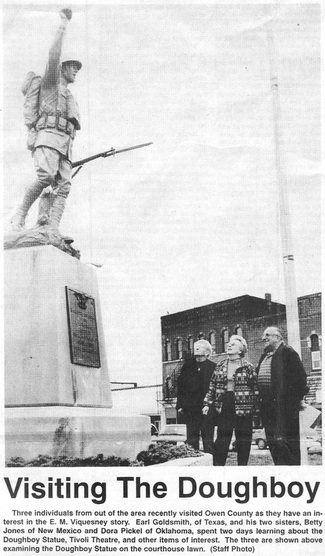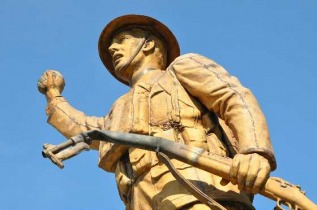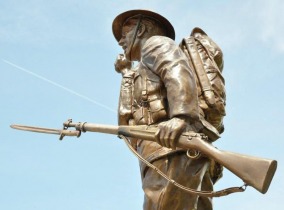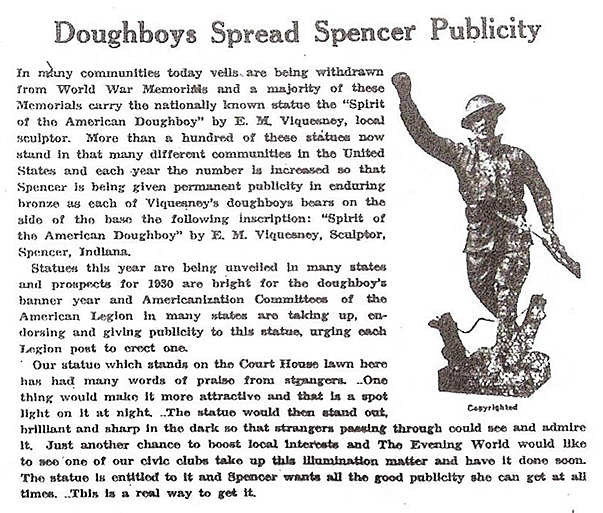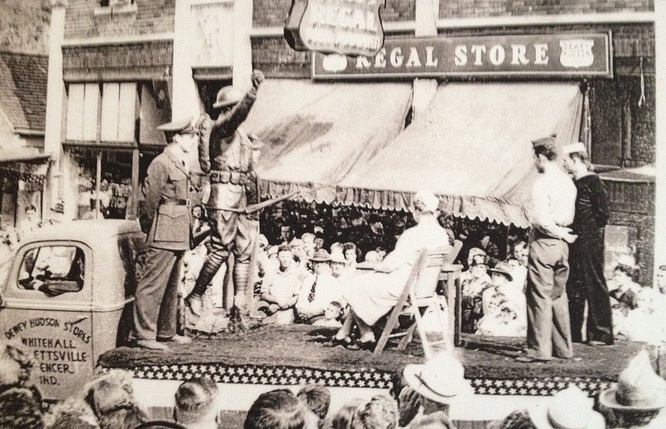SPENCER, INDIANA
(Where sculptor E. M. Viquesney was born in 1876, lived most of his life, died in 1946, and is buried.)
N 39° 17.151 / W 086° 45.746
Copyright version 1920, sheet bronze.
Smithsonian Art Inventory Control Number: 47260033.
Copyright version 1920, sheet bronze.
Smithsonian Art Inventory Control Number: 47260033.
On northwest corner of Owen County Courthouse lawn and square.
The front plaque inscription reads:
IN GRATEFUL RECOGNITION
OF THE
PATRIOTIC SERVICE
RENDERED BY
THE MEN AND WOMEN OF
OWEN COUNTY
DURING THE WORLD WAR
1917-1918
A plaque inscription on the back of the base reads:
THIS TABLET IS ERECTED
IN MEMORY OF THESE MEN OF
OWEN COUNTY
WHO GAVE THEIR LIVES
IN THE WORLD WAR
1914-1918
(followed by list of names)
IN GRATEFUL RECOGNITION
OF THE
PATRIOTIC SERVICE
RENDERED BY
THE MEN AND WOMEN OF
OWEN COUNTY
DURING THE WORLD WAR
1917-1918
A plaque inscription on the back of the base reads:
THIS TABLET IS ERECTED
IN MEMORY OF THESE MEN OF
OWEN COUNTY
WHO GAVE THEIR LIVES
IN THE WORLD WAR
1914-1918
(followed by list of names)
A later plaque on the side of the base lists those missing or killed in action during World War II.
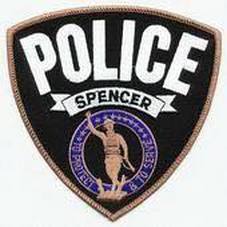
Spencer police shoulder patch.
The monument was funded by public subscription and dedicated Sunday, May 27, 1927 during the annual G.A.R. Decoration Day Service. A parade formed on Main Street and marched to the cemetery for speeches and decoration of graves. It then reformed and marched back to the courthouse square for the unveiling of the statue. The statue was presented by Beaver Club representative Howard Briceland to American Legion Post Commander Elmer Call, who accepted in on behalf of the county citizens. Mr. Briceland then called on E.M. Viquesney, the sculptor and a Spencer resident, for a few remarks. After music and group singing by the crowd of 3,500 in attendance, the cords that drew the flags from the statue were drawn by Mrs. W.A. Highet, whose son was killed in the war, and Mrs. Wm. Call, whose son was the first Owen Countian to be killed in it.
The stone base on which the statue stands was quarried at Romona, taken to Bedford where it was milled, and returned to Spencer in the spring of 1926.
A coat of gold paint was applied to the statue at the same time the Owen County Courthouse dome was painted in 1983.
In 1994, the Courthouse was placed on the National Register of Historic Places. The filed application contained many references to the statue and E. M. Viquesney and his many contributions to Spencer, which were helpful in gaining this recognition.
During Memorial Day weekend, 2001, a memorial was dedicated along a nearby walk to honor those who served in the Civil War, Spanish-American War, World War I, World War II, Korea and Vietnam.
Spencer was also the home of T. Perry Wesley, who accumulated what was at the time of his death, the world’s greatest knowledge and file of information about Viquesney and his "Spirit of The American Doughboy." Mr. Wesley died June 4, 2001, just 25 days before his 96th birthday. His health was such that he was not able to be present a few days earlier for the Memorial Day dedication mentioned above.
In 1994, the Courthouse was placed on the National Register of Historic Places. The filed application contained many references to the statue and E. M. Viquesney and his many contributions to Spencer, which were helpful in gaining this recognition.
During Memorial Day weekend, 2001, a memorial was dedicated along a nearby walk to honor those who served in the Civil War, Spanish-American War, World War I, World War II, Korea and Vietnam.
Spencer was also the home of T. Perry Wesley, who accumulated what was at the time of his death, the world’s greatest knowledge and file of information about Viquesney and his "Spirit of The American Doughboy." Mr. Wesley died June 4, 2001, just 25 days before his 96th birthday. His health was such that he was not able to be present a few days earlier for the Memorial Day dedication mentioned above.
Around 3:00 in the morning of November 8, 2008, the statue was vandalized. The bayonet blade was broken off, and the end of the rifle bent. The total damage was estimated at over $10,000. Thanks to security cameras, three suspects were arrested, and the bayonet blade recovered. Two of the suspects pled guilty in August, 2009 with each receiving jail time, fines equal to one-third of the damages ($3,570), and 32 hours per month of community service to veterans for one year. One suspect was also sentenced to electronic home monitoring for one year. The third suspect chose to go to trial.
THE DEPRESSION PUTS A DAMPER ON SALES
Just after the stock market crash of 1929, Viquesney tried to boost the fortunes of his hometown of Spencer by hyping his Doughboy, claiming bright prospects for the following year, 1930. Sadly, such was not to be the case: Due to the ensuing Great Depression, sales of "The Spirit of the American Doughboy" slipped until 1933, when not a single one was sold. Sales began to recover modestly in mid-1934, when Viquesney switched from manufacturing the statue in sheet bronze to cheaper cast zinc.
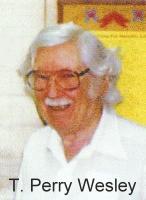
Perhaps the Spencer Doughboy's biggest booster was T. Perry Wesley, the former editor of the local newspaper, The Spencer Evening World. Mr. Wesley spent 50 years researching E. M Viquesney and his works, and after his retirement, published his findings in local Chamber of Commerce reports.
But perhaps Mr. Wesley was a bit too zealous in claiming the Doughboy as Spencer's own: Although his letterhead bore the logo "Home of the Doughboy", and the back of the postcard photo he took (the one at top left on this page) bears the description below, Viquesney actually created his Doughboy while living and working in Americus, Georgia.
But perhaps Mr. Wesley was a bit too zealous in claiming the Doughboy as Spencer's own: Although his letterhead bore the logo "Home of the Doughboy", and the back of the postcard photo he took (the one at top left on this page) bears the description below, Viquesney actually created his Doughboy while living and working in Americus, Georgia.
SPENCER, INDIANA'S "PHANTOM" DOUGHBOY
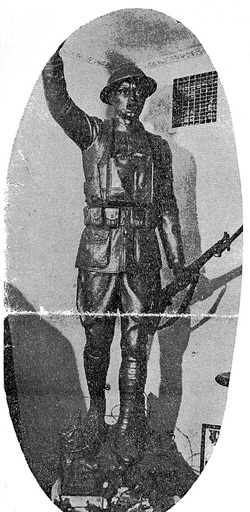
The Doughboy in Viquesney's studio.
Besides the Doughboy in front of the courthouse, there was one more in Spencer, at least temporarily. After Viquesney moved his studio to his residence in 1939, it was known there was a full-size cast zinc version of his Doughboy statue standing inside for some time as a sales display. It's pictured at left from the Indianapolis Sunday Star, February 11, 1940. It may have been lent or rented out to other towns to feature in patriotic holiday parades such as July 4, Memorial Day, and Armistice Day (now Veterans Day). We suspect this because of a photo we received from Stanley Griffith, who grew up working in Viquesney's Tivoli Theatre. Stan sent us a 1939 photo of the same model Doughboy mounted on a flatbed truck parading down Sale Street in the town of Ellettsville, Indiana - except Ellettsville doesn't, and never did have, a "Spirit of the American Doughboy". Since Ellettsville is just few miles from Spencer, it's very likely this is the Doughboy that stood in Viquesney's studio and was out on loan to Ellettsville for watever the town was celebrating that day.
Whatever became of this Doughboy isn't known. We do know there was a full-size "Spirit of the American Doughboy" listed among the effects of Viquesney's estate sale in 1947, which was probably this one. There is evidence it ended up in the possession of Frederic L. Hollis, who, until at least 1958, carried on Viquesney's business after the artist's death. A 1951 letter to Hollis suggests melting the statue and reusing the metal to make a copy of Viquesney's WWII creation, "The Spirit of the Fighting Yank". It is thus possible that the "Fighting Yank" that stands in Chicago, Illinois, the last and only one installed after 1951, may be this Doughboy, recycled.
Whatever became of this Doughboy isn't known. We do know there was a full-size "Spirit of the American Doughboy" listed among the effects of Viquesney's estate sale in 1947, which was probably this one. There is evidence it ended up in the possession of Frederic L. Hollis, who, until at least 1958, carried on Viquesney's business after the artist's death. A 1951 letter to Hollis suggests melting the statue and reusing the metal to make a copy of Viquesney's WWII creation, "The Spirit of the Fighting Yank". It is thus possible that the "Fighting Yank" that stands in Chicago, Illinois, the last and only one installed after 1951, may be this Doughboy, recycled.
Below: Stan Griffith shot this interesting picture of a 1939 photo on display inside a historic building window in the town of Ellettsville, Indiana. It had us going for a while, thinking perhaps this was an undiscovered Viquesney Doughboy. But since Ellettsville has no record of a Viquesney Doughboy, this is probably the same statue pictured above that Viquesney kept in his Spencer studio as a sales display, and likely lent or rented out to nearby towns like Ellettsville to feature in patriotic holiday parades.

